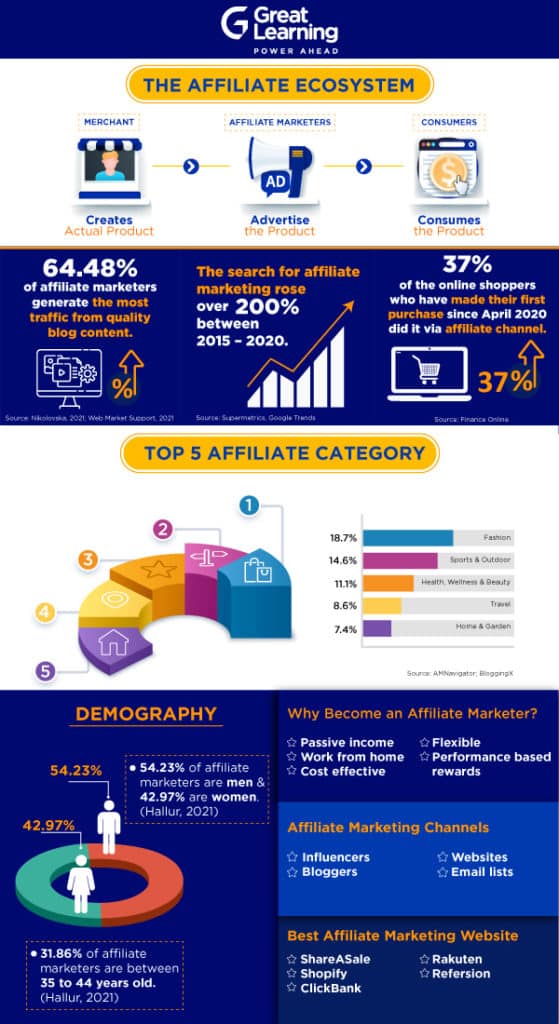- What is Affiliate Marketing?
- Affiliate Marketing - MODUS OPERANDI
- Reasons why companies spend on Affiliate Marketing
- Types of Affiliate Marketing
- Best Affiliate Marketing Programs
- How to Start Affiliate Marketing?
- How to Affiliate Marketers Get Paid?
- High Ticket Affiliate Marketing
- Affiliate Marketing Websites
- How Amazon Affiliate Marketing Works
- Example of Affiliate Marketing
- Conclusion
Everyone is fond of social media these days. Be it Instagram or Facebook. Netizens spend hours and hours checking feed, stories, bios, etc. While the one set of netizens just sit, relax and enjoy this feed. There is this other kind of netizens who create content and earn dollars through affiliate marketing. Sounds interesting, right?
Let’s deep dive into the nitty-gritty of Affiliate Marketing, starting from the basics.
Affiliate Marketing course is increasing, and it’s a win-win strategy for both companies and affiliates. Businesses have realized that affiliate content can enhance their brand awareness and initiate a cost-effective way of sales that the businesses happily share a part of their profits with the affiliates.
What is Affiliate Marketing?
Affiliate marketing is basically an advertising model where a company pays a small commission to any individual for advertising their product and service to generate sales.
These individuals are usually termed as “Affiliates.” The affiliates place ads/ refer/ market the products and services on their website, app, or blog to generate sales. In return for this, commissions are paid by the company on the leads that get converted into sales.
Putting everything simply, affiliate marketing is the method of earning a commission by advertising another person’s/company product. It is kind of similar to a salesperson who earns incentives for each sale. The only difference would be that you don’t work for the company.
Affiliate Marketing is one of the powerful ways to make money online. The greatest part is that you don’t need to invest your time in creating the products or services that you plan to serve your target group. Check out this free affiliate marketing course.
Affiliate Marketing – MODUS OPERANDI
Let’s have a look at the participants involved in Affiliate Marketing:
- Merchant – The seller, retailer, brand, or vendor who creates the actual product. These merchants can be from solo entrepreneurs to any start-up to any Fortune 500 company. The merchants sometimes are not actively involved in the affiliate marketing program.
- The Affiliate Marketers – Affiliates or publishers may range from single individuals to entire companies. An affiliate basically advertises products and services to attract potential customers to purchase the product/service.
- The Consumer – As we know, “Consumer is the King.” It holds true in the Affiliate marketing setup as well. Ultimately it is the purchase by the consumer that runs the entire affiliate marketing program. The affiliates try to place the products in the right set of target consumers so that they may end up buying. Sales would only lead to commissions.
- Affiliate Networks – These affiliate networks are typically the website and platforms that bridge the gap between the merchant and affiliates. The merchants can list their products and services in these networks, and affiliates may choose any product or service that they are interested in promoting. The affiliate network possesses the catalog or database of numerous products. This database makes it easier for the affiliates to choose the right product they want to promote.
Let’s understand how affiliate marketing works.
First of all, Affiliates need to find an affiliate network/program that they are interested in. Based on the same, the affiliates can check the program details, the types of products and services involved, the commission offered payment terms and conditions, etc.
If the program details are appealing, then affiliates can sign up and wait for confirmation from the affiliate network. Post acceptance, the affiliates can start content creation and may add the custom links the program provides. When any user clicks on these links and makes a purchase, the affiliate earns a commission.
Affiliates can work with companies or affiliate networks and can promote the affiliate links on their website, newsletters, and social media. The affiliate networks send a payment when the affiliate reaches the minimum payment level.
The payment methods vary from one network to the other and can be paid to the affiliate through cheques, bank transfers, and online payments.
Reasons why companies spend on Affiliate Marketing
“Affiliate Marketing spending in the United States alone is predicted to reach $8.2 billion by 2022” – Statistica
Affiliate Marketing produces great benefits for the advertising company/ merchant and the affiliate. The company yields profits from low-cost advertising along with innovative marketing efforts from its affiliates. The affiliate gets a noticeable space in terms of views for their channel or website, along with earning additional income or commission. The ROI for affiliate marketing is high as the company pays on traffic converted to sales. Usually, the cost of advertising is borne by the affiliate.
Here are the top 7 reasons why companies spend on Affiliate Marketing:
- Access to Broader Market – In the Affiliate Marketing model, the companies are channelizing their marketing efforts through an affiliate who possesses direct access to many like-minded audiences. Due to this, the companies are able to target a broader market and reach a particular niche. In Affiliate Marketing campaigns, the audiences of the influencers bring in a new database that widens the audience base for any company.
- Low-cost advertising – Affiliate marketing campaigns do not need an advertising team, ad space, or ad visuals. Rather there is a dependency on the affiliates on how they will come up with their promotional content. Companies have an initial effort of selecting and examining the affiliates, but once made, very little effort is required from the company to market their products. This makes Affiliate Marketing most fascinating for the companies.
- Less ongoing cost – As most of the marketing activities are carried out by the affiliates, they would definitely incur a cost for the same. As Affiliate Marketing is mostly commission-based, the companies would pay affiliates only when the sales that they bring in. The companies do not pay for the operational cost incurred by the Affiliates. This model makes it easy for the business to manage their cashflows without any disruptions, unlike the Pay per click model, where the companies are required to pay for every click that leads to their website. Affiliate Marketing counts in only when a purchase is made from any campaign by the affiliate.
- Less Risk – Low cost depicts less risk. There is hardly any risk of loss as payments are made only when the sales occur. It is kind of perfect for businesses with less budget.
- Right choice of Traffic – In most cases, the affiliates are chosen by the company. It certifies that the traffic visit company’s website by “choice” and not by “chance.” This happens because the affiliates resonate with the brand, and that leads to the right set of traffic that finds the brand useful.
- Flexibility – The companies may change their affiliate program to small or big based on their scaling decisions at a little or no cost.
- High Return on Investment – Affiliate marketing has a much higher ROI than other marketing strategies. The major reason for the same is that the targeted audience would hear about a particular brand through word of mouth communication within the influence of the affiliates that kind of validates the utility of the brand.
With every benefit accompanies the disadvantages too. Affiliate marketing channels are subject to fraud if proper protocols are not maintained. The companies have less creative control over the advertisements done by the affiliates.
Also Read: Digital Marketing Salary
Types of Affiliate Marketing
According to Statistica, “84% of Publishers and 81% of Advertisers in the United States have turned to Affiliate marketing”. Affiliate Marketing Campaigns have grown massively as a low-cost form of digital marketing in the past few years. The associated companies do not create any marketing campaign house. Rather, the company’s products are advertised by successful affiliates through various marketing mediums like blogs, video content, podcast, etc. There are three main types of Affiliate Marketing Model. Let’s now discuss these advertising models in a bit more detailed form.
- Related Affiliate Marketing – This advertising model involves the promotion of a product or service that lies in the niche of the affiliate. The affiliate possesses enough expertise and influence to generate traffic. The level of authority that the affiliate possesses is treated as a trusted and reliable source. The affiliate, however, doesn’t claim the use of the product/service. For instance, in a blog that talks about “How to pay IT returns online,” you may observe advertisements from various financial institutions that offer investments to reduce the Income Tax under various sections.
- Involved Affiliate Marketing – In this advertising model, there is a genuine and deep connection between the affiliate and the product/service they are promoting. Here, the affiliate showcase confidence and the positive experience after using the product/service. Their experiences serve as a reliable source of information. For instance, a solo traveler influencer who is very active on Instagram posts about her recent visit to Kashmir along with updates and reels. She also keeps posts about the places where she stayed acts as a reliable piece for information for other such solo travelers. She acted as an affiliate for her audience as well as the hotels/hostels where she stayed during her visit.
- Unattached Affiliate Marketing – In this advertising model, the affiliate has no connection with the product or service they are promoting. The affiliates sometimes have less or no related skills or expertise in the genre of the product. Here, the affiliate publishes the ads that promote the seller’s product. For instance, if you visit any portal that offers you to buy cosmetics online and you observe an ad from an EdTech company along with a Real Estate buyer. In this case, the cosmetic portal acts as an affiliate for both the EdTech company as well as for the real estate company since they are using the cosmetic portal to promote their businesses.
Best Affiliate Marketing Programs
In this segment, we’ll talk about the best Affiliate Program that one can sign up for and earn a steady income:
- Amazon Affiliate Marketing – Amazon is one of the world’s major affiliate marketing programs. The content creators, publishers, bloggers sign up for this program to have the Amazon product/ services shared on their websites. They act as an affiliate and promote the Amazon goods to their followers to receive compensation for the sales that are generated from their sites. Amazon has strict rules for the type of sites that host promotions for them. Amazon does not allow sites that contain replicated content, obscene or offensive content, promote illegal acts of violence or any other content that is harmful to the public. Amazon prefers websites that are active and have fresh content according to Amazon’s standards.
- eBay Affiliate Marketing – eBay Partner Network is basically eBay’s affiliate marketing program. The affiliate on eBay can earn a commission when a buyer bids on/purchase any product within 24 hours of clicking the eBay purchase links on the affiliate’s site. If the buyer wins the auction for any submitted bids within 10 days of the bid, the commission is paid to the affiliate. Commission rates range from 1% – to 4%, depending on the category of items sold.
- Etsy Affiliate Marketing – Etsy is a global marketplace for vintage goods and unique items. Etsy promotes its items through various marketing channels, including affiliate marketing partners. Affiliates should submit an online application in Etsy’s affiliate program portal to apply. Affiliates should meet the criteria as specified by Etsy to become eligible marketing partners – the age at least 18, possesses an active, unique website, and have a brand identity. Once affiliates are approved, Etsy pays an amount as commission for the sales they procure. The rates for commission may vary and are paid based on the order price. Etsy possesses the right to terminate any agreement at any time for any reason. Etsy also holds the right to withhold compensation amounts for any genuine reason.
Also Read: Importance of digital marketing for businesses
How to Start Affiliate Marketing?
- Identify your Niche
This is the most important and critical step of Affiliate Marketing. Typically, one should choose from their interest area. Also, the niche that one is identifying should be helpful to the target audience. The interest of affiliates may range from fashion to wellness and health, to education, to travel, to sports, to interior designing.
One needs to choose a product that falls under the category of their knowledge. One can’t just start a blog on fitness and have no idea about it. If one is a cooking enthusiast, then they should find a product used in cooking so that a blog can be written about it or one can talk about it in a YouTube video. Also, focus on choosing a specific category in the initial stages. If the chosen niche is food, then narrow it down to maybe vegan food, which would help in fighting the immense competition.
- Choose a Platform
There are many mediums that can be adopted to become an affiliate marketer. Affiliates may choose a social media platform like Instagram, Facebook, LinkedIn, or the most popular ways are YouTube or Blogging. Both of the options come cheap. There are many tutorials online where one can learn about blogging easily but if you are new to blogging and want to learn how to start blogging, then enroll in this online blogging course offered by Great Learning. Once the blog is up, affiliates may start putting up affiliate links and wait for the money to flow in. Affiliates should make sure to optimize the site so that it is reflected by the right people. In the case of YouTube, there is no need to pay anything for owning a YouTube channel. It depends on the creativity and the right implementation of SEO techniques that can help in grabbing eyeballs. To comply with the guidelines of the platforms, it is necessary to disclose that the links added are affiliate links.
- Recognize an Affiliate Program
In this step, affiliates should research the various affiliate programs, like Amazon, Shopify, eBay, etc. Further, they should identify their needs, keeping the chosen platform and niche in mind. There are different kinds of affiliate programs like
- High-paying, low-volume affiliate programs
- Low-paying, high-volume affiliate programs
- High-paying, high-volume affiliate programs
The Affiliates can decide on their aim and what fits into their niche with the level of expertise they possess to work on an affiliate program.
- Create Content
Now, it’s time to put the car in gear. Affiliates should focus and strategize what kind of content they want to deliver by understanding what the consumers are looking for. Affiliates should not make the content only for affiliate purposes. Rather the aim should be to focus on improving the user experience and solving the reader’s/viewer’s problem. The level of the quality of content that is provided will ultimately guide the level of success achieved.
- Focus on driving traffic
There are many ways through which the traffic can be increased.
- The first option is online advertising, also referred to as paid media. Affiliates can go for this option only when the platform is doing well and they can bear the costs. They can also roll out PPC campaigns to increase the leads.
- The other option is SEO. Affiliates can develop content that is SEO friendly and strategically place keywords to increase rankings.
- The last option is to create an email list of potential buyers. This list can be prepared by adding people from the affiliates’ network or by asking the visitors on their site to sign up for the emailing list. This is a direct way to connect with people.
How to Affiliate Marketers Get Paid?
Affiliate Marketing is a contemporary approach to earning money through commissions. The affiliates can be master graduates or college dropouts. As long as they are promoting the merchant’s product, they are eligible for commissions.
If the affiliates sign up for Amazon Affiliate Program, all they should provide is the payment details to Amazon, and they will automatically receive their monthly payments without any hassles.
Here are the three other ways through which affiliates get paid.
- PayPal – It is one of the world’s largest online payments processors that is extensively used by affiliate companies to make payments to their partners. Creating a PayPal account is absolutely free with no maintenance charges. PayPal charges 3 – 5% of transaction fees.
- PingPong – This is another popular service specifically for cross–border payments. PingPong is widely used by Amazon affiliates. PingPong charges 1% as transaction fees and also provides an automated FIRC. Creating a PingPong account is absolutely free with no maintenance charges. The service activation of PingPong could take up to 2-3 days.
- Payoneer – This is another reliable cross-border payment solution, extensively used by Bloggers, Affiliates, Freelancers, and Amazon sellers. The transaction cost charged by Payoneer is 2%.
The income made by Affiliate marketers may vary from a few hundred dollars to a few making six figures. It totally depends on the type of product or service being marketed, the influence of the affiliate in the marketplace, the reach of the affiliate, and the amount of time invested in the marketing of the products. Affiliates who have good reach, high influence, and spend more time in marketing products earn more money.
| Quick Facts As per Awin Report, the Content and Blogger Websites earn almost 40% share of the publisher commissions in the U.S. |
High Ticket Affiliate Marketing
Every organization promotes its product and services to the right set of customers. In the above read, we discussed the “Traditional Affiliate Marketing” approach, where a company allows a third party or individual to promote their products. The affiliate mentions an “affiliate link” for the products promoted. The price of the product and product type decides the commission earned by the affiliate.
The Traditional Method of Affiliate Marketing is usually for low-ticket items, where the affiliate gain profit on the front-end sales. Sales usually occur when a new customer visits the website and purchases the product. If the traffic is less, the probability of earning commission also becomes less.
High Ticket Affiliate Marketing differs from Traditional Affiliate Marketing on the basis of product types. High Ticket Affiliate Marketing is an approach that gives large profits on fewer sales. Using such an approach, an affiliate may sell a product type that would give more commission on fewer sales. Such products are known as High-ticket items as they provide a commission of sometimes $1000 on their sales. These high-ticket items comprise Gold Jewellery or Fancy electronic items. There can be other high-ticket items present in the company portal. An affiliate should recognize such products to increase their sales.
Gaining more commission by few sales on a high-priced item is better than getting less profit on a large product sale. If affiliates pick up high ticket (high priced) products, it will lead to an increase in the commission as well. Let’s have a look at the key strategies that an affiliate might take while promoting a high–ticket item.
- Experience the Product – Before promoting any product, the affiliate should buy, use and experience the product. Based on their experience, the best product features can be highlighted during the promotion. This would lead to a better conversion rate and also maintain the reliability of the personal brand created by the affiliate.
- Add Interesting and detailed review – Affiliates should pen down positive and interesting reviews about the product. The detailed review should comprise the benefits of working on the product. Consumers prefer to purchase goods that solve their problems. If the affiliate is a video content creator, then a proper explanation of the working/usage of the product can be shown with the help of high-quality video. If the affiliate is a blogger, then they may share their personal testimonials or case study with recommendations to validate the utility of the product.
- Be Transparent – No product or service is perfect. An affiliate who clarifies the pros and cons of using any particular product gains more trust from their followers. It is always advisable to be transparent and share all product details with authentic information.
- Engage audiences with free bonus items – To stay competitive in the marketplace, affiliates may include free bonus items like free eBooks, videos, reports, or other things that may engage customers. Affiliates should make sure that the free bonuses should be highly valued and relevant to the affiliate product. Affiliates should make their audiences aware of this free gift post their purchase from the affiliate link provided on their website.
| DO YOU KNOW According to Statistica, “The largest affiliate networks include,Amazon Associates: 900,000+ active affiliates, ShareASale: 700,000+ active affiliates, Awin: 205,000+ active affiliates, ClickBank: 100,000+ active affiliates |
Affiliate Marketing Websites
Let’s have a look at the best Affiliate Marketing Websites
- ShareASale Affiliate – ShareASale has spent over 20 years growing its network by building relationships, creating cutting-edge technology, and guiding merchants and affiliates to maintain a successful affiliate marketing channel. There is a variety of merchants that deal with all kinds of products on this website. Affiliates have a wide choice of products that they may promote.
- Shopify Affiliate Program – Shopify Affiliate program comprises content creators, influencers, educators, entrepreneurs who inspire their audience to launch successful businesses along with earning competitive referral commissions. To apply for the Shopify affiliate program, one must own and run an active website, possess an audience, create original content like blogs, videos, seminars, etc. Affiliates can receive a commission for merchants that they refer to a paid Shopify plan through the affiliate link. By helping merchants set up and grow their shopify stores, affiliates can maximize their referral potential and earnings. Shopify doesn’t restrict the number of merchants. This allows the affiliates to earn more by referring more merchants.
- ClickBank – This is a global E-Commerce platform and also an affiliate marketplace with a variety of merchants. ClickBank was founded in 1988. This global giant has more than six-million clients worldwide. Clickbank basically focuses on lifestyle products created by businesses from all across the world.
- Rakuten Marketing Affiliates – This is a leading organization with over 20 years of experience in affiliate marketing. Rakuten connects with advertisers and consumers and helps the affiliates to monetize their content. Rakuten deals with a wide range of products from high electronics to pet suppliers.
- Refersion – This is designed for enterprises that drive E-Commerce growth through influencers, ambassadors, and affiliate relationships. Refersion helps businesses in creating and launching their promotion network. The all-in-one platform of Refersion enables businesses from recruiting and onboarding affiliates to setting commission structure, to track performance, generate reports, and pay them a commission in a user-friendly interface. One of the best features of Refersion is its personalized affiliate portal, where the affiliates have their dashboards where they can track their activities, manage commissions and receive incentive payout.
How Amazon Affiliate Marketing Works
Amazon is one of the popular and most widely used websites. Amazon particularly delivers anything at your doorstep from anything low priced as a pencil to something expensive like a diamond engagement ring.
Amazon Affiliate Marketing Program helps bloggers, content creators, and publishers to monetize their traffic. One interesting fact about this program is that once a consumer visits an affiliate’s website and clicked the affiliate link, the affiliate will earn a commission for all purchases that the consumer makes in the next 24 hours. Since Amazon has a plentiful and diverse set of products results in more products in the consumer cart.
Affiliate marketers can share products/services and available programs on the Amazon portal with their traffic through customized linking tools and can monetize on qualifying purchases and customer actions. Bloggers, content creators, and publishers who possess a qualifying website can apply for the Amazon affiliate program.
To be a part of the Amazon affiliate program involves a thorough review by Amazon staff and meeting the pre-decided sales quota (3 sales within 180 days of applying). In case the application is rejected, the affiliate is not eligible for reconsideration. Once the affiliate is approved, commissions can be earned based on site visitors buying products and services from Amazon. Typically, an Amazon affiliate earns a 10% commission for a qualified purchase. Rates are usually fixed by Amazon based on program and product category. At certain events, Amazon offers special commissions too.
The affiliates can join the Amazon Affiliate Program through the following steps
- Sign Up – The affiliates can join the Amazon community where tons of content creators, publishers, and bloggers are already earning with Amazon.
- Recommend – The affiliates share a million products with their audiences. Amazon has customized linking tools for individual bloggers, large publishers, and social media influencers.
- Earn – The affiliates can earn up to 10% commissions in eligible purchases and programs. The competitive conversion rates of Amazon help maximize the earnings of the affiliates.
Example of Affiliate Marketing
Here’s is an interesting example of Affiliate marketing
- A Crafter by hobby and a Youtuber by profession creates beautiful handmade DIY (Do-it-yourself) projects. As you observe the details given take the potential crafter to the right website from where all the raw materials of this project were purchased. While the Consumer purchases his preferred raw material, the Youtuber earns a commission through Affiliate Marketing.
Conclusion
There is no doubt that Affiliate marketing is a strong marketing channel that drives value for the merchants by enhancing brand awareness, reaching the niche target audience, spreading positive validation of products through word-of-mouth. The affiliates not only get rewarded for their promotional efforts, but many affiliates also manage to establish their personal brand for themselves.
To put together everything, in a nutshell

There is a lot that can be learned about affiliate marketing and if you are interested then check out the Digital Marketing courses offered by Great Learning. The course would help to develop strong fundamentals of affiliate marketing and help you on the right path to becoming an influential affiliate marketer.
So, what are you waiting for, start your Affiliate Marketing journey today!








